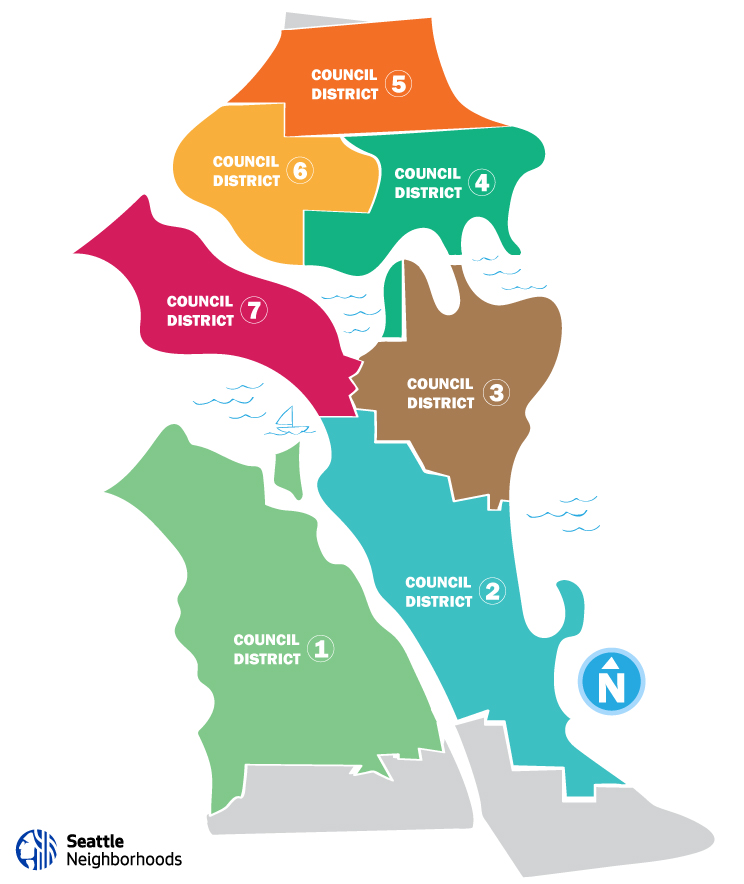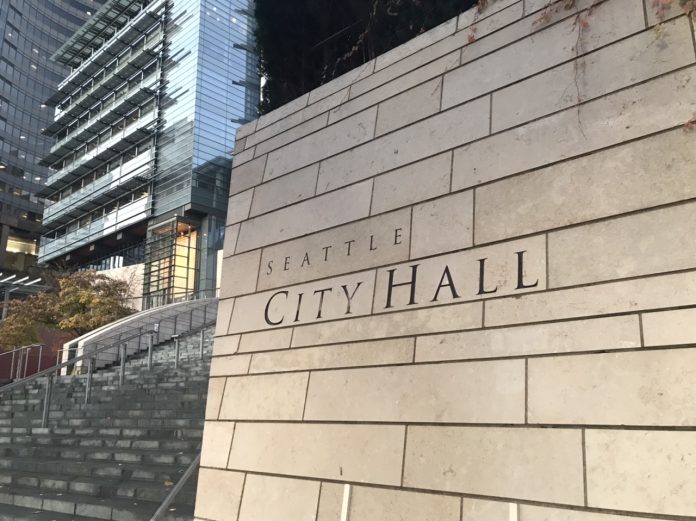In a normal zero-ending year, the attention of the United States at the beginning of April turns to the Census. Required by the Constitution, the Census may be groused at and argued about in court, but it always happens.
Of course, 2020 is not a normal year. But the Census rolls on, and will be inevitably followed by redistricting. Since being formed in 2013 for the 2015 election, this will be the first time that Seattle’s seven district-based council seats will be subject to reorganized boundaries.
As pointed out by Gene Balk in The Seattle Times, the city’s growth focused on some neighborhoods, so redistricting will be uneven. Seattle’s 7th District, represented by Andrew Lewis and containing Downtown, Queen Anne, and Magnolia, grew by 33,000 people. The 5th District–with Debora Juarez representing Lake City, Bitter Lake, and Northgate–added 10,000 residents. All the other districts fall in between.
Breaking the growth down to districts misses one small fact. Seattle added more people than the population of any single council district in 2013. The original districts averaged 88,000 people. The total growth over the past decade was 120,000 people. The growth may be uneven, but it totals 140% the original district size.
Seattle added more people than a single city council district. We should be following that up by adding an actual city council district. Seattle needs a 10th councilmember.

Underrepresentation is a feature at all levels of government in the United States. The topic of increasing representative bodies frequently starts at the top. The House of Representatives has been capped at 435 members since 1929. In that year, one Representative was seated per 280,000 people. Now it’s closer to a Representative per 780,000 people. Compared to other developed countries, the United States is somewhere near 150 members of Congress short for our population.
It’s not quite that bad in Seattle. But each Seattle Councilmember represents a population larger than most Washington cities. Our population increase is comparable to the whole population of Kent, where there are seven councilmembers. Of the largest 20 cities in Washington for 2019, none exceed 35,000 people per seat, much less Seattle’s current 83,000 people per seat. Larger cities of Spokane, Tacoma, Vancouver, and Bellevue average around 25,000 people per seat. Smaller cities like Federal Way, Pasco, and Marysville average 12,000 people per seat. At those levels of representation, Seattle would have 30 councilmembers and 62 councilmembers respectively.
*This is different than the 88,000 people mentioned above. Calculations in this section are based on the entire council, not just the district-elected seats. That allows comparison between different jurisdictions that have different at-large and district formats.

Comparable cities across the country also have larger city councils, with a caveat. Big jurisdictions like New York City and Chicago have 50-member councils. Of the remaining top-25 largest cities, the average council size is 13 members. Cities that diverge from this are ones that have experienced very fast growth over the last decade. Such cities that are less than a million people, including Fort Worth, Austin, El Paso, and Columbus, do have less than 10-member councils. Of them, only Austin saw more change per-councilmember than Seattle.

Adding a tenth councilmember would make the council an even number, something that brings to mind gridlock and the need for a tie breaker. However, 10 of the largest 25 cities have even-numbered councils. Also, the current Seattle City Council doesn’t have many close votes. Out of 195 votes by this Council, only four had more than a single opponent. Only one vote failed.
The immediate reaction to expanding any public body is perpetually “what’s it going to cost for more of these people?” The going salary for a councilmember is $130,000 per year plus the staff of three to four people. The overall Legislative Department 2019 budget is $16.3 million with the vast majority going to the 99 full-time jobs. The budget for the entire Council operation is 0.2% of the City’s $5.9 billion budget. Another seat would cost about $560,000 or a 0.01% increase in the budget.

The second question is “Why?” That may be best answered by asking why did we settle at nine members in the first place? It appears that we just kind of fell into it. We spent twenty years between 1869 and 1890 tinkering with wards, expanding city boundaries, and switching between district reps and at-large councilmembers. Then in 1890, Seattle developed a Home Rule charter with a bicameral legislature which had nine members on a Board of Delegates and a separate 16-member House of Delegates. At the time, Seattle’s population of 42,000 people was represented by 25 people. Still not as representative as Aberdeen, but closer.
The bicameral legislature lasted a decade, and wards were abolished in 1910. The council settled back to nine at-large members. This coincided with the city’s voracious appetite for annexation and skyrocketing growth. By 1910, the city annexed Ballard and West Seattle, and the population was 237,000 people or 26,000 per councilmember.
But the council stayed at nine members until 2013 with the adoption of Charter Amendment 19. (Pro Tip: Don’t Google anything with the number 19 these days.) This created the district system, but kept it within the existing framework of a nine-member council.
And that is where we stand today, a decade into the district councilmember experiment. Having seven councilmembers elected by district seems to be working, having made the 2019 election really interesting. We are experiencing the same accelerated growth that caused Seattle to try four different government forms over just as many decades at the turn of the last century. We can be just as bold.

Where would we carve a new district? There are a few options, starting with not actually adding a district. If we are happy with seven districts, that’s perfectly reasonable. Whenever the city adds more than 100,000 people in a decade, add another at-large member.
But if we choose to add another district, it will focus between the three districts that saw the most growth: Downtown and Capitol Hill. This has an added benefit. One of the original complaints against districts was that they “packed” minority populations into a single district, while “cracking” other neighborhoods–like Capitol Hill–apart. Giving fast-growing Capitol Hill a strong position in the new district would address those original issues.
Additionally, district populations must be relatively even, but not exactly. The 2013 districts were within a 5,000 person range, but it was the Downtown districts–Districts 3, 4, and 7–that were at the maximum end of that range. They started over 90,000 people while District 6 around Ballard, Loyal Heights, and Greenwood started at 86,000. The high starting point of Downtown districts exacerbated the disparities in growth. We know where growth is planned. Districts with higher planned population growth should start at the lower end of the district population range.
As important as the specifics is the process. To prepare for redistricting in 2023, the mayor and council will set up a five-member Districting Commission and a special master for establishing council boundaries based on the census. This must be done by October 21, 2022.
Or we can start the process immediately. Appoint the Districting Commission now to get a jump on doing this work. Give them an expanded mandate to analyze whether other positions in the city should be elected and should be based on districts. Let’s start with an elected police accountability board.
And that is really the point. We should not just question the people representing us, but also question the structure of that representation. We frequently treat certain concepts as inviolate. City boundaries. Number of council members. Budget categories. But at one point, these were all created by an actual human being. It should be our duty to interrogate whether they are representing our values or if they are a carryover from a different time. Adding councilmembers as our city grows is a recognition that we are a different city in different times. Seattle needs a 10th Councilmember.
Ray Dubicki is a stay-at-home dad and parent-on-call for taking care of general school and neighborhood tasks around Ballard. This lets him see how urbanism works (or doesn’t) during the hours most people are locked in their office. He is an attorney and urbanist by training, with soup-to-nuts planning experience from code enforcement to university development to writing zoning ordinances. He enjoys using PowerPoint, but only because it’s no longer a weekly obligation.


